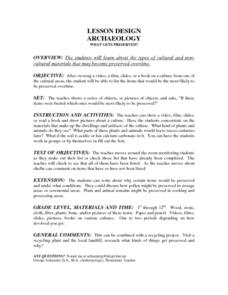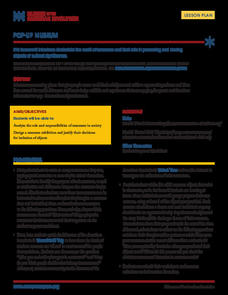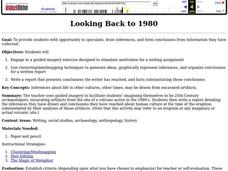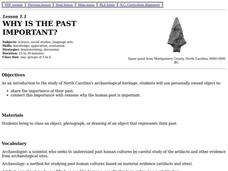Curated OER
Archaeological Soils
Students evaluate how archaeologists use soils to interpret sites and determine components of a soil sample.
Curated OER
Artifact Identification-What is it?
Students observe an artifact and make an inference about the artifact's purpose. They are going to role-play as archaeologists by using artifacts to hypothesize about the lives of past people.
Curated OER
Stonehenge: Solving Ancient Mysteries
Learners explore archeologists and anthropologists and the tools and methods they use to gather and interpret scientific evidence. They research current archaeological excavations and contact the scientists working at these digs.
Curated OER
Pottery-making Methods
Students become experimental archaeologists using three methods of pottery making before the invention of the pottery wheel.
Curated OER
Ancient Greece
Sixth graders examine the research that archaeologists have done on a Late Bronze Age shipwreck in order to work out the extent of trade in the Eastern Mediterranean during this period, with emphasis on the involvement of the Mycenaeans...
Curated OER
The Forgotten Cities
Students recognize and identify gaps in historical and archaeological evidence and how that evidence is interpreted. They explore the history of the Indus cities and identify what was left behind that survived for archaeologists to find...
Curated OER
School Sleuths Treasure Map
Students are explained how a grid and compass work. They are also explained that archaeologists use grids as a record of the exact location of artifacts. Students define the term datum as a point of reference on grids from which all...
Curated OER
Detectives of the Past: Dr. Archaeology Travels Back in Time
Students watch a video and complete a webquest to gain a better understanding of the historical significance of the first known civilization, Mesopotamia.
Curated OER
Archaeology- State Map
Students study state maps. In this map skills lesson, students identify the states' location and how to use a legend. Students complete photocopies of the state map.
Curated OER
Archaeology What Gets Preserved?
Students view a video on a culture and list what would be preserved over time. In this investigative lesson students study preservation and what gets preserved in different cultures.
Channel Islands Film
Cache: Lesson Plan 3 - Grades 4-5
Should the excavation of what is believed to be the cave of the Lone Woman of San Nicholas Island be allowed to continue? As a practice exercise designed to prepare pupils for a timed writing exam, individuals read two Los Angeles Times...
Channel Islands Film
Arlington Springs Man: Lesson Plan 1
Learning to craft quality questions is a skill that can be taught. Class members use the Question Formulation Technique to learn how to create and refine both closed-ended and open-ended questions. They then view West of the West's...
Channel Islands Film
Arlington Springs Man: Lesson Plan 3
Imagine being part of a team of scientists that discover the oldest human remains in North America. Imagine being part of the crew that documents this discovery. Class members get a change to be part of such an exciting adventure in a...
Museum of the American Revolution
Pop-Up Museum
Museums offer more than interesting exhibits—they are key to keeping history alive. An immersive activity uses a virtual field trip to show academics the importance of museums in preserving history. Young historians learn how museums are...
Curated OER
Social Studies: Exploring Boston's Big Dig
Students, in a high school class for autistic children, take a virtual tour of Boston's "Big Dig" and the artifacts discovered there. During weekly lab sessions, they discover the processes involved in artifact preservation. Using...
Curated OER
"it's All in the Cellar"
Seventh graders examine the process of constructing a site plan map at archaeological sites. They discuss the process of mapping techniques and calculation of percentages, create a plan site map of a cellar at Jamestown, and calculate...
Curated OER
Investigating the Mammoth Mystery
Fourth graders go on a virtual dig to find out where the mammoth bones found in a rural U.S. county came from. They determine whether the bones were created by humans or were they the actual remains of mammoths who walked the area during...
Curated OER
Interpreting An Archaelogical Site
Learners study the site of an archaeological dig site in order to begin looking at how they can be interpreted. They look at a soil profile and respond to a research question that simulates a real site. The other questions are used to...
Curated OER
Gridding a 2 x 2 Meter Unit
Learners use the internet to examine what happens at an archeological dig site. In groups, they practice measuring a 2x2 meter square unit and gridding it out as an archeologist would do. They review the possible solutions at the end of...
Curated OER
Archeological Thinking
Sixth graders review the differences between a historian and archaeolgists. At a recent archaeological dig site, they examine the artifacts and determine their usage. In groups, they are given a bag full of artifacts and write down what...
Curated OER
Looking Back to 1980
Pupils use clustering/mind mapping techniques to generate ideas, graphically represent inferences, organize their conclusions and write a report that presents conclusions the writer has reached, and facts substantiating those conclusions.
Curated OER
Stratigraphy and Cross-Dating
Students interpret archaeological strata using the law of superposition. They apply cross-dating to determine the age of other artifacts.
Curated OER
Tag It and Bag It: Archeology Lab Lesson
Seventh graders practice analyzing, collecting and categorizing artifacts. Using charts, they organize and interpret information about the artifacts they classified. They work together to create a graph to represent class totals and...
Curated OER
Why is the Past Important?
Fourth graders discuss the importance of North Carolina's archaeological heritage. They share with the class an object, photograph, or drawing of an object that represents their own or their family's past.
Other popular searches
- Archaeology Math
- Archaeology Videos
- Art and Archaeology
- Science Archaeology
- Archaeology Recording Form
- Archaeology Internet
- Archaeology Animal
- Material Culture Archaeology
- Olympic Archaeology
- Music and Archaeology
- Archaeology of the Future
- Archaeology Alaska

























